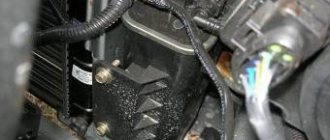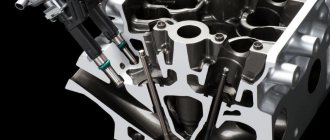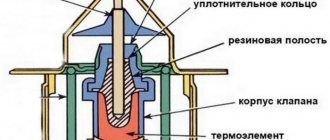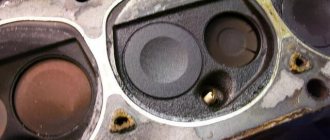Gravity valve VAZ-2123, cleaning and modification. This is the reason.
Earlier I wrote that a vacuum is created in the tank, but with warming the picture has changed just the opposite.
The absorber was purged, the solenoid valve was checked, but the route to the tank was purged with great difficulty and only with a compressor. After driving a little more I only became convinced that the tank ventilation was not working. After reading, I decided that it was worth working on the gravity valve. I poured WD-40 on the rubber, shook it and lubricated it again, but still took out the insides with two slotted screwdrivers.
The valve, in principle, worked, but the coupling field was stuck and was blown through with resistance. I took it apart and it's basically clean. And the most interesting thing is that there is no jamming of the piston in the cup.
But the height of the piston is indeed too high, which in fact prevented the valve from fully opening. I ground the bottom of the piston on a grinder and drilled a couple of holes with a diameter of 2 mm in it. to reduce flow resistance. Well, just in case, I ground down the piston guides a little and cut off the coil of the spring. I also enlarged the holes in the cup.
I assembled it like this: after generously lubricating the cuff with WD-40, I tucked it into a large glass and pushed the valve into it.
The valve vents perfectly and closes when turned over. But before connecting the hose, I decided to blow out the line itself by disconnecting the tube from the absorber
So it is blown very hard and only with a compressor. I poured carburetor cleaner into the tube several times and blew it through, and it seemed to reduce the resistance a little. It seems to me that the tube is squashed somewhere or that the hose has delaminated inside.
I'll go and watch for now. I will change the stabilizer rubber bands and at the same time inspect the ventilation tube. If the pressure continues to inflate the tank and the tube is not jammed, I will change the hose.
Source
Myths of "gravity"
Despite the fact that heating technology is being improved every year and supplemented with new progressive technical solutions and highly efficient equipment, water heating systems with natural coolant circulation continue to occupy a very significant share in the heat supply. They are widely and successfully used both in individual housing and cottage construction, and in the construction of facilities in areas where power supply is either absent or intermittent.
Rice. 2. An example of a two-pipe heating system with natural circulation
To do this, we use the example of a classic two-pipe gravity heating system ( Fig. 2
), with the following initial data: the initial volume of coolant in the system is 100 l;
height from the center of the boiler to the surface of the heated coolant in the tank H
= 7 m;
the distance from the surface of the heated coolant in the tank to the center of the second tier radiator h
1 = 3 m, the distance to the center of the first tier radiator
h
2 = 6 m.
The temperature at the boiler outlet is 90 °C, at the boiler inlet - 70 °C. The current circulation pressure for the radiator of the second tier can be determined by the formula:
For the radiator of the first tier it will be:
More accurate calculations also take into account the cooling of water in the pipelines.
Myth 1. Pipelines must be laid with a slope in the direction of flow of the coolant.
We don’t argue that it wouldn’t be bad, but in practice this requirement cannot always be met.
Somewhere the roof beam is in the way, somewhere the ceilings are arranged at different levels, etc. What will happen if the supply pipeline is made with a counter-slope ( Fig. 3
)?
Rice. 3. An example of top filling with a counter-slope
If you approach this issue wisely, then nothing bad will happen. If the circulation pressure decreases, it will be by an insignificant amount (several pascals), due to the parasitic influence of the coolant cooling in the upper bottling. Air from the system will have to be removed using a flow-through air collector and air vent. An example of this device is shown in Fig. 4
. The drain valve is used to release air when the system is filled with coolant. In “cruising” mode, this valve is closed. Such a system will remain fully operational.
Rice.
4. An example of a device for releasing air from the top filling
Myth 2. In systems with natural circulation, the cooled coolant cannot move upward.
This is not true at all.
For a circulation system, the concepts of “top” and “bottom” are very relative. If the return pipeline rises in some section, then somewhere it falls to the same height. That is, gravitational forces are balanced. It’s all just a matter of overcoming additional local resistance at turns and linear sections of the pipeline. All this, as well as possible cooling of the coolant in the lifting sections, must be taken into account in the calculations. If the system is correctly designed, then the diagram presented in Fig.
5 , has a right to exist. Moreover, at the beginning of the last century such schemes were widely used, despite their weak hydraulic stability.
Rice. 5. Diagram with an upper return pipeline
Myth 3. In gravity systems, the supply pipeline must pass over all tiers of radiators.
This is also not at all necessary.
Properly sloping supply piping under the upper floor ceiling or attic allows air to be removed from the system through an open expansion tank. However, the problem of air removal can be solved using automatic air vents ( Fig. 6
) or a separate air line.
Rice.
6. Diagram with a lower supply line Myth 4. With natural coolant circulation, radiators must be located above the center of the heat generator (boiler).
This statement is true only when heating devices are located in one tier.
If there are two or more tiers, the radiators of the lower tier can be located below the boiler, which, naturally, must be checked by hydraulic calculations. In particular, for the example shown in Fig.
7 , at
H
= 7 m,
h
1 = 3 m,
h
2 = 8 m, the current circulation pressure will be:
Here: ρ1 = 965 kg/m 3 – density of water at 90 °C; ρ2 = 977 kg/m 3 – density of water at 70 °C; ρ3 = 973 kg/m 3 – density of water at 80 °C.
The circulation pressure is quite sufficient for the operation of such a system.
Rice. 7. Single-pipe gravity system with radiators located below the boiler
Myth 5. A gravity heating system designed for a water coolant can be painlessly converted to a non-freezing coolant.
Without calculation, such a replacement can lead to a complete failure of the heating system. The fact is that ethylene and polypropylene glycol solutions have a significantly higher viscosity than water. In addition, the specific heat capacity of these mixtures is slightly lower than that of water, which requires, other things being equal, accelerated circulation of the coolant. These two factors taken together significantly increase the calculated hydraulic resistance of a system filled with coolants with a low freezing point.
Myth 6. It is necessary to constantly add coolant to an open expansion tank, because... it evaporates intensely.
Yes, this is indeed a big inconvenience, but it can be easily eliminated.
For this, an air tube and a hydraulic valve are used, usually installed closer to the lowest point of the system, next to the boiler ( Fig. 8
). Such a tube serves as an air damper between the hydraulic seal and the coolant level in the tank, therefore, the larger its diameter, the better. The less will be the level of level fluctuations in the water seal tank. Some craftsmen manage to pump nitrogen or inert gases into the air tube, thereby protecting the system from oxygen penetration.
Gravity valve Niva Chevrolet operating principle
It seemed like such an inconspicuous element, which at first glance is not important for the car, but without which it cannot work properly. Dips appear, the engine “troubles” and the gas tank may even collapse! And all this is due to a faulty adsorber valve. Many people don’t know what it is, how it works and MOST IMPORTANTLY what it affects. Today I will try to put everything into simple terms and describe the main symptoms of a malfunction. It will definitely be useful, so read and watch...
THE CONTENT OF THE ARTICLE
First, let's start with a definition.
An adsorber (from Latin sorbeo - absorb) is a car system that serves to capture gasoline vapors that come out of the tank. When the engine is running, they are sent to the fuel injection system, namely the intake manifold . When the engine is turned off, some of the vapors are captured by the separator (it directs them back to the tank), and the remaining vapors enter the adsorber, where they are neutralized.
Determining possible damage
see also
We have figured out why the adsorber is needed, now let’s determine the signs indicating its failure. Considering the quality of fuel at gas stations in our homeland, this part often becomes dirty and fails.
Any malfunction of this mechanism can be easily determined by obvious signs:
- Damage to the absorber - the fact that this mechanism of your car has problems can be determined by hearing a hissing sound when opening the tank, it indicates the accumulation of an excess amount of gasoline vapor.
Excessive pressure appears in the tank when you open the lid, there is a moment when the contact area with the external environment is small, and the pressure is quickly “relieved” through it, and the tank “hisses”, similar to a bottle of soda.
If the problem is not “treated”, the tank will shoot off the lid at some point, in addition to repairing the tank, this promises serious liability problems (possibly criminal), because it is impossible to predict where the lid will fly, the speed of which is comparable to the speed of a cannonball.
- Valve failure - this will be recalled by instability of the engine at idle speed, the car will begin to randomly increase (lower) the speed itself and stall.
In the event of a breakdown, the adsorber is often removed completely, we will discuss how to do this below, but there are no unnecessary parts in the car, it is worth remembering. If you don’t want to remove and gut the ECU, you can try to fix everything yourself. The weakest point in the absorption kit is the VAZ 2114 valve.
On the VAZ 2115, a decrease in speed was noticed while driving, the car choked and stalled while driving, after the car stood, the problem temporarily disappeared.
Before repairing, you need to make sure that the problem is here:
- Use a flat-head screwdriver to unscrew the fastener on the motor cover (be careful, the fastener is plastic, you shouldn’t break it), and then very carefully remove the clamps.
- We remove the part and blow out the valve. If air does not pass through, then the valve is operational, and the breakdown is elsewhere; if air passes through the valve, then you have found the problem.
A valve failure, in addition to unstable idle speed, will soon give you CheckEngine and significantly increased consumption.
Why was the adsorber created?
Actually, this is a tribute to the environmental standard, namely EURO-2. Essentially this is a large filter that catches light hydrocarbons. According to the new standards, it is unacceptable for gasoline vapors to enter the atmosphere, because this contributes to air pollution.
Also, couples should not enter the car interior, because this is, to put it mildly, harmful! ON old carburetor cars, such a filter and its valve simply did not exist; the system there is a little different. BUT the carburetor went away along with the old standards, now there is only an injector and a filtration system is MANDATORY.
Components
In fact, this is a large plastic jar with activated carbon inside, because it is this composition that perfectly fights gasoline vapors. The main parts can be described as follows:
As you can see, there is absolutely nothing complicated. Separator - serves to catch part of the gasoline, then sends it back to the tank. Gravity valve - almost never used, but it is needed in emergency situations, for example during accidents, it prevents fuel from overflowing from the tank (for example, when a car overturns).
The pressure sensor is a very necessary thing - it monitors the pressure of gasoline vapors inside the tank, if necessary, it opens and resets it, preventing the structure from being damaged.
The filter part is, as I wrote above, a large jar into which coal powder is poured, in fairly large granules. This is done so that vapors can pass and condense freely.
Connecting tubes are needed to connect all the main parts, filters, sensors and valves, I think this is clear.
Solenoid valve - used to switch modes for capturing gasoline vapors, we will talk about it in more detail below.
What elements make sense to repair?
Repair of most parts is not provided.
- Cracked, damaged or clogged fuel lines must be replaced immediately.
- It is impossible to clean dirty fine filters or adsorber. They just need to be changed.
- A clogged coarse filter can be easily cleaned if necessary. It only needs to be changed if the mesh is damaged.
- In some cases, it makes sense to repair the gas tank. Holes that appear as a result of physical impact can be soldered or welded. However, you must follow safety rules. Otherwise, an explosion of gasoline vapors accumulated in the tank is possible.
- There is no point in soldering or cooking a rusted gas tank. As a rule, there will probably be several pockets of corrosion in it. Once you solder one hole, you'll soon find new ones.
- The fuel level sensor and fuel pump also cannot be repaired. The only exception is bad contacts at the connection terminal. In this case, it will be enough to remove the corrosion or contamination to revive the device.
- Repairing injectors involves cleaning the jets. This requires dismantling the parts and washing them with a special cleaner. Similarly, it is possible to restore the performance of the throttle. If washing does not help, the parts need to be replaced with new ones.
- A broken pressure regulator is easier and cheaper to replace than to try to repair.
In most cases, repairs come down to localizing the fault and replacing failed parts.
How the system works - operating principle
Why am I focusing on the solenoid valve, because it is practically the key one in this system.
For a better understanding, I am posting a diagram of an injection car, and in this case it is a VAZ of the 10th family.
So, fuel vapor rises to the top of the tank and stops at the separator, which is combined with a gravity sensor (as I wrote above, it prevents fuel from leaking out in the event of an accident - capsizing from the tank). In it they partially condense and return back (in the form of liquid fuel).
However, the other part of the evaporation bypasses the gravity valve and passes into the adsorber, where they actually accumulate. Accumulation occurs when the engine is not running! IT IS IMPORTANT.
After starting the engine, the solenoid valve opens - thereby connecting the adsorber cavity (where the gases are trapped, as it were) with the intake manifold or throttle assembly (in different cars in different ways). THE PROCESS OF THE SO-CALLED PURGE BEGIN! The vapors are mixed with air (from the street), which is supplied through the throttle assembly, then enter the intake manifold and then into the engine cylinders, where they are burned with the air-fuel mixture.
The system is very simple if you understand how it works.
Knock in the transfer case of the new Chevrolet Niva. Direct from the factory
If leaks occur, replace damaged consumables. Domestic SUVs perform quite well on roads with different surfaces. But quite a lot of problems can arise with them. For example, a knock in the transfer case of the new Chevrolet Niva. This problem is not uncommon. Therefore, every owner of such a car should know the causes of this problem. Let's look at popular reasons When communicating with car owners, you can often hear the question of why the speed on the Chevrolet Niva does not drop.
Operating the engine in this mode is undesirable for any car model; high speeds not only have an unpleasant effect on the hearing, but also lead to increased fuel consumption. Such a problem can arise suddenly, everything seemed to be working perfectly, and then suddenly a high idle appeared. Many drivers, both experienced and beginners, are very puzzled by this problem.
Why the speed on the Chevrolet Niva does not reset will be discussed in this article. Let's analyze all known variants of such a problem and ways to solve it. Many car owners, after such a malfunction occurs, seek help from specialists, but in most cases the malfunction can be fixed with your own hands. We will tell you what needs to be done for this in this article for everyone interested in this issue. Why do you need a properly set idle speed?
When it comes to a car, the concept of idling can be attributed to the operation of the engine when the gear is off or when the clutch pedal is depressed. In such cases, the engine runs without load, that is, there is no transmission of torque from the power plant to the drive wheels.
For different engines, idle speed can range from to rpm. If their indicator is less than the recommended value, the engine will stop when the clutch pedal is pressed. An increase in their number, in addition to a significant increase in gasoline consumption, leads to accelerated wear of engine parts
This is why it is so important to keep their number within the recommended range.
Idle speed adjustment is carried out by several components and assemblies installed on the vehicle. These include an injector, a fuel pump, and various sensors, which can be mechanical or electronic. This also includes the throttle valve, fuel pressure regulator and some other devices. The number of revolutions is greatly influenced by the opening angle of the throttle valve, which regulates the amount of air entering the engine power system.
The idle air valve also takes part in mixture formation, which is needed to provide air supply bypassing the throttle valve. In some cases, an increase in their number may be caused by an incorrectly adjusted gas pedal drive. Why the speed doesn’t drop There are quite a lot of reasons for the appearance of such an unpleasant phenomenon, let’s try to understand this issue together and decide how to get out of this situation.
Most often, in injection engines, speed reduction does not occur due to the fault of the throttle assembly, in which contamination occurs.
This is interesting: Removing and installing the Chevrolet Niva rear door lock drive
What does the adsorber valve do?
Many problems are related specifically to the adsorber valve. In essence, this is a very simple device that opens or closes under certain conditions (the engine is running or turned off).
If the valve works well, then there are no problems at all; you may not even know about its presence in your system.
However, when a breakdown occurs, for example, the adsorber cavity itself becomes clogged, or the valve does not work. The car may subsequently suffer serious damage. Because the cavity is not purged, and the pressure from the tank is not relieved.
Signs of a malfunctioning canister valve
As it becomes clear, problems arise with the power system:
It is also worth noting that the reason is not always in the valve; often the can of activated carbon itself (that is, the adsorber cavity itself) can become clogged. If necessary, it must be replaced or disassembled and cleaned - dried, that is, the filtration of gases must be restored so that they pass unhindered.
Now a useful video.
If you experience these malfunctions, then you definitely need to look - check the valve and, if necessary, change it, fortunately it costs a penny. And also the cavity itself with activated carbon.
Is it possible to remove
Some motorists neglect environmental standards and remove the adsorber valve. The words are basically like this: “why do I need it, the car has become slower, the consumption has become higher, I’ll throw it away altogether.” But realistically, is it possible to do this? Will this make the car worse?
It is worth understanding that a working system does not affect the operation of the engine at all, and even saves a little fuel, because the vapors that remain in the main body are then burned out in the engine. Of course, you should not expect that the savings will be huge, but you get a few kilometers of mileage.
Of course, you can clean it, the car is simply OK with it! It will even be better, because the evaporation from the tank will not condense (purify), but will go directly into the atmosphere. That is, you kind of remove all the cans - valves and give an open air flow to the tank.
Physically, they do it this way: they hang a fine filter from a carburetor VAZ on the hose from the separator, and gasoline vapors escape into the atmosphere. The hose from the adsorber valve is blocked, the engine is flashed ( chip tuning ), otherwise an error will appear, that’s all!
However, there are also disadvantages to this:
Pros of unplugging:
I think the system is quite useful; personally, I was often annoyed when a carburetor car smelled of gasoline, wherever possible. If you inhale and then get a headache, this system allows you to avoid this, saves fuel a little and does not pollute the atmosphere.
This is where I end, I think my article was useful to you, read our AUTOBLOG, subscribe to the channel.
(
32 votes, average: 4.47 out of 5)
Rice. 2-77a. EURO-2 gasoline vapor recovery system:
1 - hose for adsorber and gas tank valve; 2 — gas tank valve; 3 — gas tank valve hose, steam line; 4 — throttle pipe with receiver; 5 — adsorber and throttle pipe hose; 6 - adsorber; 7 - clamp; 8 - bolt; 9 — adsorber mounting bracket; 10 - nut; 11 — steam line and gravity valve hose; 12 — gravity valve; 13 — steam pipe; 14 - fuel tank.
The gasoline vapor recovery system (VAR) consists of a carbon adsorber 6 (Fig. 2-77a) with a purge solenoid valve, gas tank valve 2, gravity valve 12, steam line tube 13 and hoses 1, 3, 5 and 11.
Gasoline vapor passes through gravity valve 12 and valve 2 of the gas tank. The gravity valve prevents fuel from leaking out of the tank when the vehicle rolls over, and the gas tank valve prevents the pressure in the fuel tank from becoming too high or low.
After passing through the valves, gasoline vapors enter adsorber 6, where they are absorbed by activated carbon. The second fitting of the adsorber is connected by hose 5 to the throttle pipe, and the third is connected to the atmosphere. When the engine is turned off, the solenoid valve is closed; in this case, gasoline vapor does not enter the throttle pipe. After the engine starts, the injection system controller begins to send control pulses to the valve. The valve opens and the sorbent is purged: gasoline vapors are discharged through hose 5 and the throttle pipe into the receiver.
Rice. 2-77b. EURO-3 gasoline vapor recovery system:
1 — hose of the throttle pipe and the adsorber purge valve;
2 — solenoid valve for purge of the adsorber; 3 — hose of the purge valve and adsorber; 4 - adsorber; 5 — steam pipe hose; 6 — throttle pipe with receiver; 7 - bolt; 8 — adsorber mounting bracket; 9 - nut; 10 — steam line hose and adapter; 11 — adapter; 12 — adapter and gravity valve hose; 13 — gas tank plug with safety valve; 14 — gravity valve; 15 — steam pipe; 16 - fuel tank. The ban on the emission of gasoline vapors into the atmosphere was introduced in the Euro-3 standard.
In this case, the evaporation of fuel from the tank is a natural phenomenon. To prevent gasoline vapors from entering the environment, the gas tank ventilation hose (steam line) is connected to a special device - an adsorber.
The filter element of this part absorbs harmful emissions and ensures that the car meets environmental standards.
If you open the tank and hear “Pshik”... — Lada 2114, 1.6 l., 2009 on DRIVE2
...then there is an obvious problem in the ventilation of the fuel tank. Something similar happened last year, but I didn’t pay attention until recently. One day, approaching the car, I smelled a serious smell of gasoline, walked around the car, looked under it and, to put it mildly, gasped! There was a puddle on the asphalt and gasoline was steadily dripping from the tank drop by drop, even if you put your palm up and wet it! Such movement was observed when it was +25 or higher outside, as well as in the tank 3/4 or more. In a lying position, with a flashlight, the leak was found, shown in the photo below.
After scouring the forums, it was concluded that the separator drain hose was plastic and had simply dried out over time and shortened, which is why it was not fixed properly. Having removed the fitting from the tank, some kind of gasket fell out of it. In principle, it became clear why it was leaking, but then the question is, why is excess pressure created in the tank? We search the forums further and find out that on 1.5i engines, a safety valve (8) is installed in the section of the line on the adsorber between the separator (9) and the gravity valve (7).
1.5i
Let's go further and look at the 1.6i engine diagram
1.6i
There is no safety valve in the system; its role is played by the cover itself. But the blow-out lid is very tight; I tested several of them in the store. Having unhooked the fitting from the adsorber and blown into it, I realized that something was wrong in the line, and the culprit was found. The gravity valve had become sour and rusty, and because of this the system was not purged. Next, the ventilation scheme of the carburetor nines was examined.
At number 21 we see a two-way valve that works in both directions, and it works harder to release pressure than to retract. I bought it at the car market for 130 rubles and went to the garage. The old plastic hose was thrown out and replaced with a gas-resistant rubber hose, and the clamps were freshened. At the second end of the separator, which went to the gravity valve->adsorber, I stuck a short hose from the low crankcase ventilation and brought the valve to the filler neck area. There was an elastic band, just for it)
Afterwards a full tank was filled, and active skating took place. There is no longer excess pressure in the tank, no gasoline leaks are observed. There is a slight aroma of gasoline, but only if you get closer to the tank flap. Therefore, you can now throw out the adsorber, since it is also excluded from the system. On the throttle, the adsorber fitting is plugged with a piece of hose with a bolt screwed into the sealant. Long live the free space under the hood)
What is an adsorber for?
When the engine is turned off, gasoline vapors that accumulate in the fuel tank rise to the filler neck. From there they go to the separator, condense and flow into the gas tank. However, some of the vapor does not have time to turn into liquid. They are passed through a gravity valve and sent through a steam line to the adsorber. There the vapors pass through the activated carbon and are absorbed by it.
When the engine is started, the canister purge system comes into operation. The ECU opens the solenoid valve and the accumulated vapors, along with air, are sent into the cylinders. Thus, the evaporated gasoline burns in the engine and does not enter the atmosphere.
The Chevrolet Niva adsorber is located in the engine compartment near the expansion tank.
Replacement Instructions
Replacing the purge valve
If the valve knocks loudly, it needs to be adjusted. For this purpose, it has an adjusting screw. Its head is filled with epoxy. The polymer prevents the screw from unscrewing spontaneously. A malfunction in the electromagnet power circuit can be eliminated by cleaning the connector contacts.
The work is performed with one screwdriver in the following order:
Replacing the adsorber
In addition to a screwdriver, you will need a 10mm wrench. The work order is as follows:
Removing the adsorber from the fuel system is unacceptable. This part compensates for pressure differences that occur during cooling and heating of the gas tank. In addition, the operation of the purge valve is controlled by the engine ECU. Therefore, you cannot simply plug the hose outlet - the on-board computer will generate an error. If you leave the tube unplugged, dust and dirt will be drawn into the gas tank.
Smell of gasoline, gravity valve
I got the smell of gasoline in the cabin with the windows open. The smell is coming from the trunk, that's for sure. No visible leaks were found. I checked the drive, many blame the gravity valve. Well, let's figure it out...
There is a lot of dust, apparently blowing from the ventilation valve
The valve itself was pulled out together with the neck, because... It was not possible to remove it locally. And then I had to worry about taking it off. I removed it using WD40, 2 screwdrivers and some kind of mother. Very tightly pressed. The valve was in working order, purged, no dirt. I blew it out and cleaned it to a shine, just in case. It seems to have helped... I only drive the Shnivy on weekends, so time will tell whether I dug there or not
Selection of components and manufacturing materials
PP pipes in the heating system
After the advent of polymer pipes, polypropylene (PP) gravity heating systems became very popular. This material is easy to process; a minimum of equipment is required to connect individual sections.
However, not every type of these pipes is intended for installation as a heating element. Let's consider the main selection criteria:
- Presence of a reinforcing layer . A polypropylene gravity heating system can be exposed to high temperatures - up to 95°C. To maintain the original shape of the pipe, a rigidity element is required, which is a layer of foil or fiberglass;
- Wall thickness . In a gravity heating system with a closed expansion tank, high pressure can be created. To avoid damage to the main line, polypropylene pipes must be of class PN20 or higher. The thickness of their walls depends on the diameter.
This pipe can be used to equip the accelerating manifold. However, to achieve a temperature difference, it is recommended that the return line be made of steel. In addition to reducing the temperature of the coolant before entering the boiler, this material helps to reduce hydraulic resistance.











